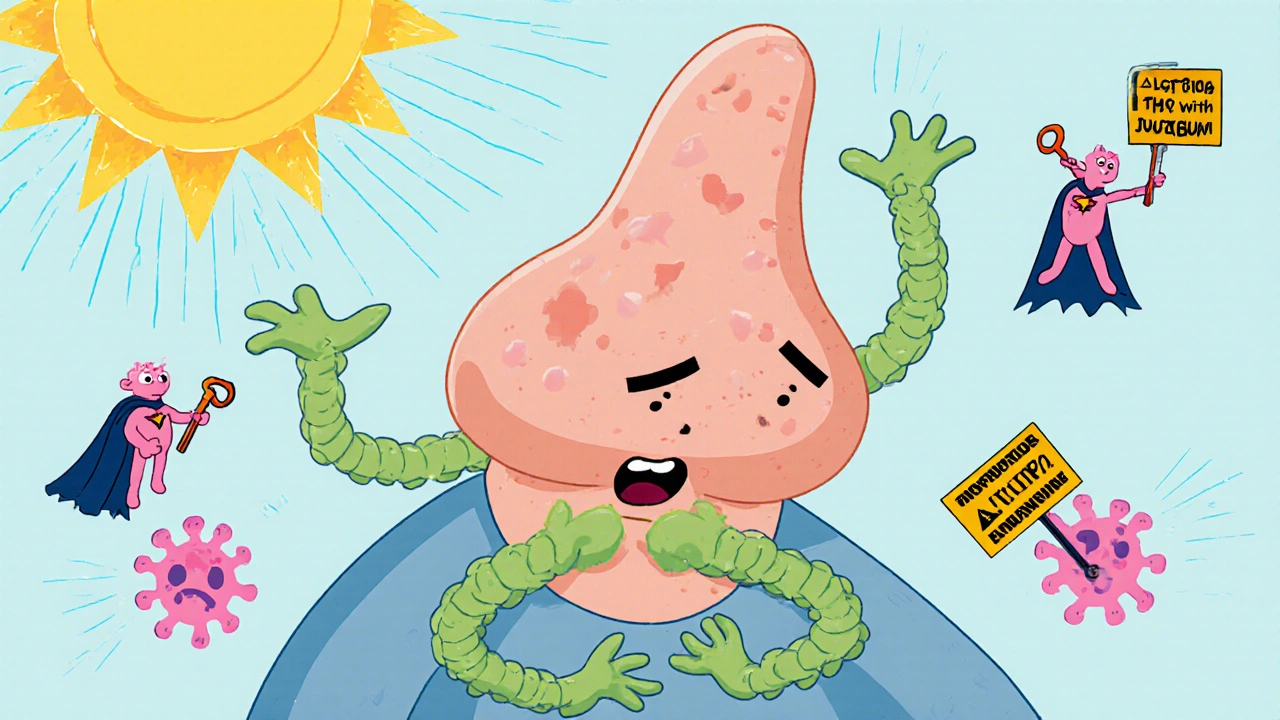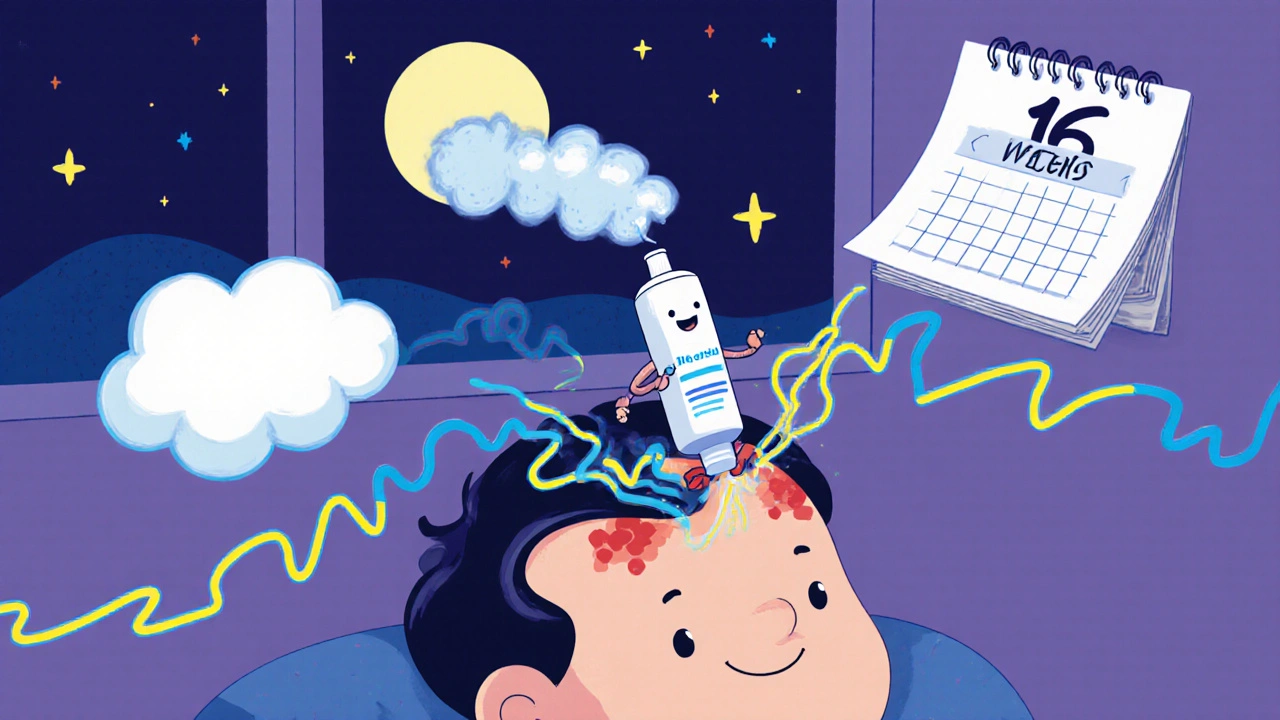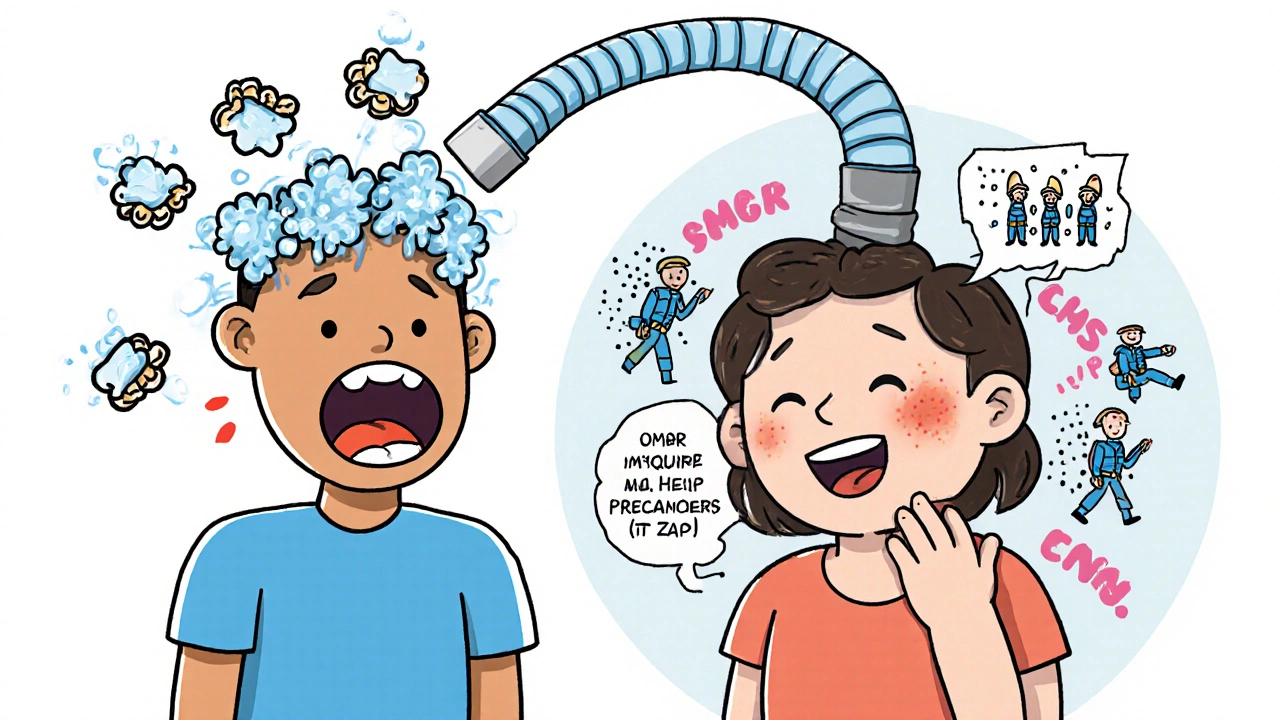
Imagine noticing a rough, scaly patch on your nose or scalp that won’t go away. It doesn’t hurt. It doesn’t itch much. But it’s there-year after year. That’s often how precancerous skin lesions start. Left untreated, some can turn into squamous cell carcinoma, a common type of skin cancer. One of the most effective ways to stop this before it starts? Imiquimod.
What Is Imiquimod?
Imiquimod is a topical cream, usually sold under the brand name Aldara. It’s not a chemotherapy drug. It’s not a laser. It doesn’t cut or burn. Instead, it talks to your immune system. When you apply it to the skin, imiquimod triggers local immune cells to recognize and attack abnormal cells. This makes it especially useful for treating actinic keratosis, the most common type of precancerous skin lesion.
Actinic keratosis shows up as dry, scaly, sometimes reddish patches. They’re caused by years of UV damage from the sun. People over 40, especially those with fair skin or who’ve spent a lot of time outdoors, are most at risk. In Australia, where UV levels are among the highest in the world, these lesions are extremely common.
Imiquimod works by activating toll-like receptor 7 (TLR7) on immune cells. This turns on a chain reaction: dendritic cells wake up, T-cells get mobilized, and cytokines like interferon flood the area. The result? The body clears out the damaged skin cells itself. It’s like training your immune system to be a better skin guard.
How Is It Used?
Imiquimod isn’t applied like a moisturizer. There’s a strict schedule. For actinic keratosis on the face or scalp, most doctors recommend applying a thin layer three times a week-for example, Monday, Wednesday, and Friday-for 16 weeks. That’s over four months. It’s not quick. But it works.
For some patients, a shorter 2-week course is used for very thin lesions, but this is less common. The cream is left on the skin for 8 hours, then washed off. Patients are told to apply it at bedtime so it stays on overnight. Sun exposure should be avoided during treatment because the skin becomes more sensitive.
It’s not just for the face. Imiquimod is also used on the arms, legs, and back-anywhere actinic keratosis appears. The treatment area is usually limited to the visible lesions and a small border around them. You don’t cover your whole body.
What Happens During Treatment?
Here’s the truth: imiquimod doesn’t feel nice. The skin reacts. Redness, swelling, crusting, and flaking are normal. Some people get burning or itching. In about 30% of cases, the reaction is strong enough to make patients consider stopping. But this reaction is actually a sign it’s working.
Think of it like a vaccine sore. The inflammation means your immune system is active. In clinical trials, patients who had stronger skin reactions were more likely to have complete clearance of lesions. One study published in the Journal of the American Academy of Dermatology found that 75% of patients using imiquimod for 16 weeks saw full clearance of actinic keratosis, compared to 11% using a placebo.
It’s not for everyone. If you have an autoimmune disease like lupus or psoriasis, your doctor may avoid it. Same if you’ve had organ transplants or are on immunosuppressants. Your immune system is already overworked. Adding imiquimod could cause unpredictable reactions.

How Does It Compare to Other Treatments?
There are other ways to treat precancerous lesions. Cryotherapy (freezing with liquid nitrogen) is fast and common. It works in minutes. But it only treats one lesion at a time. If you have 15 spots on your scalp, that’s 15 painful freezes. Plus, it doesn’t prevent new ones from forming.
Fluorouracil cream is another option. It kills abnormal cells directly. But it causes severe redness and peeling for weeks. Many people can’t tolerate it. Imiquimod, while irritating, tends to be better tolerated over time because the reaction builds slowly.
Photodynamic therapy uses light and a photosensitizing agent. It’s effective but expensive and requires clinic visits. Imiquimod is applied at home. You don’t need to travel. That’s a big plus for people in rural areas or those with mobility issues.
Here’s how they stack up:
| Treatment | Duration | Side Effects | Home Use? | Clearance Rate |
|---|---|---|---|---|
| Imiquimod | 16 weeks | Moderate redness, itching, crusting | Yes | 70-75% |
| Cryotherapy | Single visit | Pain, blistering, scarring | No | 65-70% |
| Fluorouracil | 2-4 weeks | Severe inflammation, ulceration | Yes | 60-70% |
| Photodynamic Therapy | 2 sessions | Burning, light sensitivity | No | 75-80% |
Imiquimod’s biggest advantage? It treats the whole area, not just visible spots. That’s important because under the skin, there are often dozens of microscopic lesions. By boosting immunity, imiquimod helps clear those too. It doesn’t just remove what you see-it helps prevent new ones.
What About Skin Cancer Prevention?
Studies show that people who use imiquimod for actinic keratosis reduce their risk of developing squamous cell carcinoma by nearly 40% over five years. That’s not just about clearing a patch of skin. It’s about stopping cancer before it starts.
One long-term study in Germany followed over 1,000 patients with multiple actinic keratoses. Those treated with imiquimod had significantly fewer new skin cancers compared to those who got no treatment or only cryotherapy. The effect lasted years after treatment ended.
That’s why dermatologists in Australia, Canada, and the U.S. now recommend imiquimod as a first-line option for patients with multiple lesions or high-risk areas like the scalp, ears, and lips.
Who Shouldn’t Use It?
Imiquimod isn’t a magic bullet. It’s not for children. It’s not for pregnant women-there’s not enough safety data. If you’re allergic to any ingredient in the cream, skip it. And never use it on open wounds or mucous membranes like inside the nose or mouth.
People with weakened immune systems should be cautious. That includes those on long-term steroids, chemotherapy, or biologics. If you’re unsure, ask your doctor to check your immune markers before starting.
Also, don’t use it with other topical treatments unless your doctor says so. Mixing it with retinoids or strong exfoliants can make irritation worse.

What If It Doesn’t Work?
Some people don’t respond. Around 15-20% of patients see only partial improvement. That doesn’t mean failure. It might mean the lesions are too thick or too advanced. In those cases, doctors often switch to cryotherapy or biopsy the area to rule out early skin cancer.
If the lesion comes back after treatment, it’s not uncommon. Actinic keratosis is a sign of long-term sun damage. Even after clearing, new lesions can form. That’s why annual skin checks are critical. Sunscreen, hats, and avoiding midday sun aren’t optional-they’re part of the treatment plan.
How to Get the Most Out of Treatment
Stick to the schedule. Missing doses reduces effectiveness. Use a calendar or phone reminder. Apply only to the affected area-don’t spread it wider. Wash your hands after applying. Don’t cover the area with bandages unless told to.
Keep a photo journal. Take a picture of the lesion every 4 weeks. You’ll see the redness peak around week 6, then slowly fade. That’s normal. If you see pus, open sores, or fever, contact your doctor. That’s not typical.
Hydrate your skin gently. Use a fragrance-free moisturizer after washing off the cream. Avoid alcohol-based toners or scrubs. Your skin is under stress. Treat it kindly.
Final Thoughts
Imiquimod isn’t glamorous. It doesn’t promise instant results. But for people with precancerous skin lesions, it’s one of the few treatments that actually changes the long-term risk of skin cancer. It turns your body’s own defenses into your best tool.
If you’ve been told you have actinic keratosis, don’t ignore it. Don’t wait until it bleeds or grows. Talk to your dermatologist about imiquimod. It might be the quietest, most powerful step you take toward protecting your skin for years to come.
How long does it take for imiquimod to work on precancerous skin lesions?
Most patients see visible changes within 2 to 4 weeks, but full clearance usually takes 12 to 16 weeks of consistent use. The skin often gets worse before it gets better-redness and crusting are signs the immune system is responding. Don’t stop treatment early unless instructed by your doctor.
Can imiquimod be used on the face?
Yes, imiquimod is commonly used on the face and scalp, where actinic keratosis is most dangerous. It’s especially effective for treating multiple small lesions in these areas. However, the skin here is thinner, so irritation can be stronger. Always follow your doctor’s instructions on application frequency and amount.
Is imiquimod safe for long-term use?
Imiquimod is not meant for continuous, long-term daily use. Standard treatment lasts 16 weeks. After that, doctors typically stop and monitor. Repeated courses may be used if new lesions appear, but frequent use increases the risk of chronic skin irritation. Always discuss long-term plans with your dermatologist.
Does imiquimod cause scarring?
Scarring is rare with imiquimod. Unlike cryotherapy or surgery, it doesn’t destroy tissue physically. Instead, it lets your immune system remove abnormal cells gradually. Some patients experience temporary pigment changes-lighter or darker skin-but these usually fade over months. Proper aftercare reduces risks.
Can I use imiquimod if I have a sunburn?
No. Never apply imiquimod to sunburned, broken, or inflamed skin. Wait until the sunburn has fully healed. Using it on damaged skin increases irritation and may delay healing. Always protect treated areas from sun exposure during and after treatment.

 Health and Wellness
Health and Wellness
Pradeep Kumar
November 1, 2025 AT 18:02Wow, this is so helpful! 😊 I’ve got a patch on my nose that’s been there for years-never thought it could be precancerous. Just started imiquimod last week and my skin is *so* red, but I’m keeping at it. If I can beat this, so can you! 💪
Andy Ruff
November 2, 2025 AT 23:04Let me just say this: anyone who skips sunscreen and then thinks a cream is going to fix their decades of negligence is delusional. You don’t get to ignore the sun for 30 years and then expect your immune system to clean up your mess like some kind of magical janitor. This isn’t a Band-Aid for laziness-it’s a last resort for people who treated their skin like a beach towel.
Matthew Kwiecinski
November 4, 2025 AT 17:43Imiquimod activates TLR7, which upregulates IFN-alpha and IL-12 via MyD88 signaling pathways. The clearance rates cited are statistically significant (p<0.001) in multiple RCTs, but real-world adherence is poor-only 42% complete the full 16-week regimen per JAMA Dermatology meta-analysis. Also, the 40% reduction in SCC incidence is relative risk, not absolute. Most patients have baseline risk under 2%, so absolute reduction is ~0.8%. Don’t overhype it.
Justin Vaughan
November 5, 2025 AT 18:38Look, I get it-it’s not glamorous. It’s not fast. It’s not easy. But this? This is your body fighting for you. Every red, flaky, burning day? That’s your immune system learning to protect you. I’ve seen patients cry because it hurts, then cry again six months later because their skin is clear and they’re finally not scared to go outside. It’s not a cream. It’s a second chance. Keep going. You’ve got this.
Manuel Gonzalez
November 7, 2025 AT 10:30Thanks for the detailed breakdown. I’ve been using imiquimod for 10 weeks and the crusting around week 6 was intense, but now it’s fading. I started taking photos every two weeks-really helped me stay motivated. Also, fragrance-free moisturizer after washing off? Game changer. No more stinging.
Brittney Lopez
November 8, 2025 AT 12:51This post made me think of my mom-she’s 68, lives in Arizona, and has had actinic keratosis on her scalp for years. She was terrified of cryotherapy, so we started her on imiquimod. She’s halfway through and says it’s annoying but worth it. I’m so glad we found this option. Thank you for sharing!
Jens Petersen
November 9, 2025 AT 06:02Oh, so now we’re glorifying a $200/month cream that turns your face into a war zone? Cute. Meanwhile, dermatologists in Europe are using ingenol mebutate or 5-FU with better tolerability. And don’t even get me started on the pharmaceutical marketing machine that turned a TLR7 agonist into some kind of ‘immune hero’ while quietly burying the fact that recurrence rates hit 30% within a year. This isn’t prevention-it’s a placebo with side effects.
Keerthi Kumar
November 9, 2025 AT 06:44My aunt in Mumbai used this-she’s 72, worked in fields her whole life, sun damage everywhere… and she’s now lesion-free after 16 weeks! But, please, please, please-don’t forget the hat, the shade, the sunscreen, the reapplication… because this cream? It’s not a cure… it’s a pause… a pause in the storm… and the storm? It’s still out there…
Dade Hughston
November 10, 2025 AT 11:58so i used this and my face looked like i got in a fight with a cactus and then my husband said i looked like a zombie and i cried and then i kept going and now my skin is smooth and i think im gonna cry again but this time happy tears like why did i wait so long to do this i shouldve done it 5 years ago and now i just wanna tell everyone to stop being scared and just do it even if it hurts because your skin is worth it
Jim Peddle
November 11, 2025 AT 10:27Who funds these studies? Big pharma. Who profits from 16-week regimens? Big pharma. Who gets blamed when lesions return? You. And while you’re scrubbing your face raw with imiquimod, the real cause-environmental toxins, EMF exposure, glyphosate in your food-is still everywhere. This isn’t medicine. It’s distraction. They want you focused on your skin so you don’t ask who’s poisoning the water.
Pritesh Mehta
November 11, 2025 AT 23:53India has been using Ayurvedic pastes like neem and turmeric for centuries to treat skin irregularities. Why are we now bowing to Western pharmaceuticals? Imiquimod may work, but it’s a colonial mindset to think our traditional knowledge is inferior. We had solutions before the West had patents. Let’s reclaim our healing traditions instead of buying expensive creams that make your face look like a crime scene.